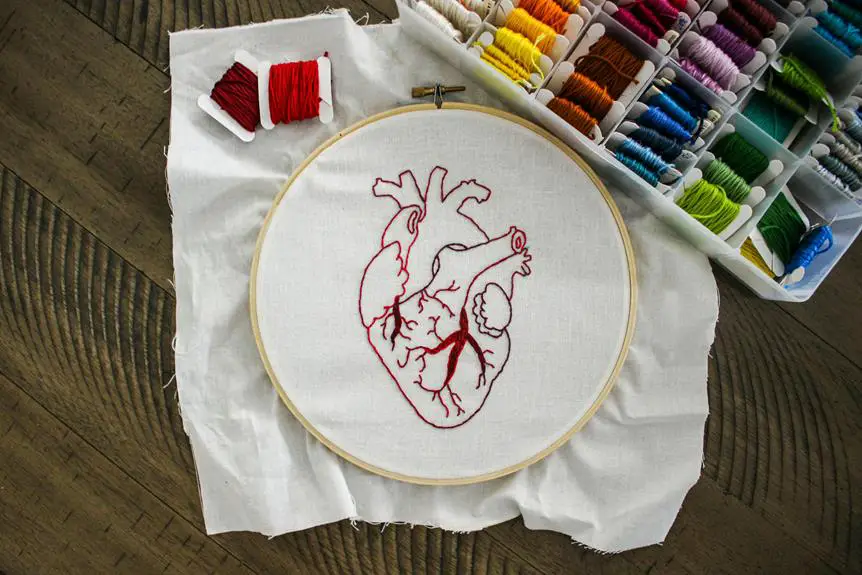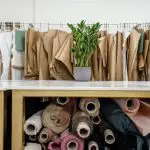When you consider the future of chenille in the textile industry, it's clear that sustainability and innovation will play crucial roles. You're likely to notice a shift toward recycled materials and eco-friendly production methods that meet consumer demands for greener options. Automation and advanced weaving techniques are set to transform efficiency, but that might not be all. Customization is becoming increasingly vital, allowing consumers to tailor their textile choices. Why is this blend of tradition and modernity so significant for producers and consumers alike? Let's explore what this means for the next phase of chenille's evolution.
Table of Contents
Increased Demand for Sustainability
As consumers become more eco-conscious, the demand for sustainable chenille fabrics is rapidly rising. You're likely noticing brands shifting towards eco-friendly options, as they recognize that customers want textiles that align with their values.
This trend isn't just a passing phase; it's changing the landscape of the textile industry.
When you choose sustainable chenille, you're opting for materials made from recycled fibers or organic sources, minimizing environmental impact.
You might appreciate that these fabrics often boast natural dyes and low-water usage in their production, further reducing ecological footprints.
Moreover, this rising demand isn't just about the fabrics themselves; it's about transparency and ethical practices in sourcing and manufacturing.
You'll want to support brands that prioritize environmental responsibility, embracing practices that protect our planet.
As you see more certifications and eco-labels on chenille products, it's easier to make informed choices.
Innovations in Production Techniques
As you explore the future of chenille, you'll notice exciting innovations in production techniques on the horizon.
Sustainable fiber development, automated weaving technologies, and advancements in dyeing processes are all set to transform how chenille is made.
Embracing these changes not only enhances efficiency but also aligns with growing sustainability expectations.
Sustainable Fiber Development
Exploring sustainable fiber development uncovers innovative production techniques that promise to revolutionize the chenille industry.
You'll find that many companies are embracing eco-friendly processes and materials that not only reduce waste but also enhance the quality of their fabrics.
- Biodegradable fibers: Manufacturers are creating fibers that break down naturally, minimizing environmental impact.
- Recycled materials: Utilizing post-consumer waste to produce chenille minimizes the need for virgin resources and diverts plastic from landfills.
- Water-efficient dyeing: Advanced dyeing techniques require significantly less water, conserving this vital resource while maintaining vibrant colors.
- Low-energy spinning: Innovations in spinning techniques decrease energy consumption, making the production process more sustainable overall.
Automated Weaving Technologies
Building on the advancements in sustainable fiber development, automated weaving technologies are now transforming how chenille fabrics are produced, increasing efficiency and precision in the manufacturing process. You'll notice machines are becoming smarter, using computerized systems to precisely control yarn tension and pattern weaving. This means you get consistent quality while reducing waste.
Here's a snapshot of how these technologies are changing the game:
| Aspect | Automated Weaving Technologies |
|---|---|
| Production Speed | Faster setup and weaving times |
| Precision | Enhanced control over yarn placement |
| Waste Reduction | Minimizes excess material usage |
| Versatility | Easily adapt to various designs |
| Labor Efficiency | Requires fewer skilled workers |
With these innovations, not only are manufacturers meeting increasing demand, but they're also achieving higher margins. This new era of weaving means you can look forward to chenille fabrics that offer both quality and sustainability, ultimately resonating with the eco-conscious consumers of today. So, as you explore future chenille options, you'll see how automated weaving stands to redefine industry standards.
Dyeing Process Advancements
Innovative dyeing processes are shaking up the chenille fabric industry, enhancing color vibrancy and reducing environmental impact. As you explore these advancements, you'll discover techniques that not only improve the quality of the fabric but also adhere to sustainability initiatives.
Digital Printing: This method allows for precise color application and reduces dye wastage, ensuring a bold, clear finish.
Low-Impact Dyes: Utilizing dyes that require less water and energy minimizes the ecological footprint of chenille production.
Eco-Friendly Fixatives: New fixatives help keep colors vibrant longer, reducing the need for harsh chemicals and promoting sustainability.
Batch Dyeing Technology: This innovation improves dye consistency and reduces water use, resulting in more efficient production processes.
Recycling Water Systems: Implementing water recycling systems helps manufacturers cut down on waste and resource consumption.
Versatility in Home Decor
Chenille adds warmth and texture to any room, transforming spaces from ordinary to extraordinary with its unique fabric qualities. When you incorporate this versatile material into your home decor, you'll discover a world of creative possibilities.
You can start with throw pillows that instantly elevate your sofa or chair. Their soft texture invites comfort, encouraging guests to sink in and relax.
Chenille rugs can serve as the centerpiece of a room, combining style and functionality while keeping your floors cozy underfoot.
Don't forget about the curtains! Chenille drapes effortlessly, offering both elegance and insulation. They've got a natural ability to diffuse light, creating a soft ambiance perfect for unwinding after a long day.
If you're feeling adventurous, think about upholstery. Whether it's a dining chair or an accent piece, chenille brings a luxurious touch and robust durability.
With its wide range of colors and patterns, chenille allows you to express your personal style without sacrificing comfort. So go ahead—explore the versatility of chenille and let your creativity shine in your home decor! Your space will thank you for it.
Fashion Forward: Chenille Apparel
Embracing chenille apparel means enjoying the perfect blend of comfort and style in your wardrobe. With its soft texture and rich colors, chenille elevates any outfit and enhances your overall look. This fabric's unique properties cater to both the fashionable and the functional, making it a must-try for any fashion enthusiast.
- Luxurious Feel: The plush fabric is gentle against your skin, offering unmatched comfort throughout the day.
- Versatile Styles: Chenille works well for various garments, from cozy sweaters to elegant dresses, fitting any occasion.
- Trend Appeal: This fabric is making a strong comeback on runways, keeping you ahead of fashion trends.
- Seasonal Flexibility: Chenille is suitable for both fall and winter, providing warmth without sacrificing style.
Incorporating chenille into your wardrobe brings a fresh twist to your style, ensuring you feel chic and comfortable at the same time. Don't miss out on this evolving trend!
Technological Enhancements in Textiles
As you explore the future of chenille, you'll notice how smart manufacturing innovations are transforming the textile industry.
These advancements not only enhance efficiency but also pave the way for sustainable production practices.
You'll see how technology is shaping the fabrics you love, making them more eco-friendly and cutting-edge.
Smart Manufacturing Innovations
Smart manufacturing innovations are revolutionizing the textile industry by integrating advanced technologies that enhance production efficiency and quality. As a brand or manufacturer, you'll want to tap into these exciting advancements to stay competitive.
Automation
Implementing robotics in your production lines can significantly reduce labor costs while increasing precision.
IoT Integration
Sensors on machinery allow real-time monitoring of production processes, optimizing performance and minimizing downtime.
Data Analytics
Utilizing big data helps you analyze consumer trends and adjust production accordingly, ensuring you meet market demands.
3D Knitting Technology
This allows for intricate designs with less waste and faster turnaround times.
AI and Machine Learning
These technologies can predict maintenance needs for machines, reducing unexpected breakdowns and enhancing overall productivity.
Sustainable Production Practices
Integrating sustainable production practices is essential for modern textile manufacturers aiming to reduce their environmental impact while meeting consumer demands for eco-friendly products. To achieve this, you can adopt innovative technologies that streamline processes and minimize waste. Example practices include using digital printing techniques that consume less water and energy compared to traditional methods.
You should also explore sourcing organic and recycled materials for chenille fabrics, which lowers the carbon footprint and promotes a circular economy. Implementing automated systems can further enhance efficiency by reducing excess fabric use during production.
Consider investing in renewable energy sources like solar or wind power to run your operations. This not only cuts back on fossil fuel dependence but can ultimately decrease your operational costs.
Additionally, you might notice that customers gravitate toward transparency. By sharing your sustainable practices and certifications, you'll foster trust and loyalty with eco-conscious consumers.
Ultimately, embracing sustainable production practices isn't just a trend; it's a vital step toward a more responsible textile industry. Adapting these methods now ensures you stay relevant and competitive in the ever-evolving market.
Customization Trends in Chenille
Customization is becoming a key trend in chenille, allowing consumers to create unique textures and patterns that reflect their personal style. You can now take control of your textile choices like never before. This trend is reshaping how you think about home décor, fashion, and upholstery.
With advancements in technology, tailoring your own chenille fabric has become easy and accessible.
- Color Selection: Choose from a wide range of hues to match your décor or wardrobe.
- Pattern Creation: Combine different patterns or create your own to make a bold statement.
- Texture Variations: Experiment with plush finishes or more subtle textures based on your preference.
- Size Specifications: Customize fabric dimensions to fit your specific needs, whether it's for a throw pillow or a wall hanging.
As you dive into the world of personalized chenille, you're not just buying fabric; you're investing in a reflection of your identity. Embrace the urge to create something that tells your story.
Revival of Vintage Chenille Designs
As you explore the world of personalized chenille, you'll notice a growing revival of vintage designs that bring nostalgia and charm back into contemporary textiles. These designs often echo the patterns and colors popular in past decades, lending a unique, warm aesthetic to modern spaces. Whether it's a retro floral print or geometric shapes reminiscent of mid-century modern furniture, vintage chenille is making a comeback.
You might find that these nostalgic patterns resonate not just with older generations, but also with millennials and Gen Z looking for one-of-a-kind pieces that tell a story. Designers are skillfully integrating these classic elements into contemporary pieces, like cushions, throws, and wall hangings.
Incorporating vintage chenille into your home can add a personal touch, creating a cozy atmosphere while connecting you to the past. Consider layering these throw pillows or using vintage-inspired blankets for a touch of classic charm.
As manufacturers rekindle interest in traditional chenille weaving techniques, you'll discover an array of possibilities. Exploring these vintage designs allows you to create a space that feels both timeless and uniquely yours. Embrace the revival of vintage chenille, and let it enrich your textile collection!
Frequently Asked Questions
What Materials Are Commonly Used to Create Chenille Fabrics Today?
Chenille fabrics typically use cotton, polyester, or a blend of both. You'll find that these materials create that signature soft, textured feel, making chenille popular for various applications, including upholstery and cozy blankets.
How Does Chenille Compare to Other Textile Options in Durability?
Chenille's softness and texture often come at a cost; it's less durable than options like canvas or cordura. If you're seeking longevity, consider these alternatives, but for comfort, chenille's hard to beat.
Can Chenille Be Used in Outdoor Environments?
Yes, chenille can be used outdoors, but it's best to choose outdoor-friendly options. You'll want to ensure it's treated for UV and moisture resistance to maintain its shape and color over time.
Are There Specific Care Instructions for Chenille Products?
For chenille products, you should hand wash in cool water with mild detergent, avoid bleach, and air dry. You'll want to keep them out of direct sunlight to maintain their vibrant colors and soft texture.
What Markets Are Showing the Highest Growth for Chenille Textiles?
You'll find that home furnishings and fashion markets are showing the highest growth for chenille textiles. These sectors cater to consumer demand for comfort and luxury, making chenille a popular choice for various applications.
- How Museums Use Sheer Scrim Fabric for Archival Displays and Exhibits - June 26, 2025
- The Ultimate Guide to Using Scrims in Film and Video Production - June 26, 2025
- A Manufacturer’s Guide to Polyester and Fiberglass Scrim Suppliers - June 26, 2025





